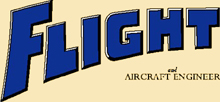Against Egypt At 4.30a.m. G.M.T. on October 31, the British and French ultimatum to Egypt expired and at 4.30 p.m. that day the first news of military operations against Egypt was given in a communique from Allied Forces Headquarters in Nicosia, which disclosed that an offensive by bomber aircraft had been launched against military targets in Egypt. A second communique said that these targets were airfields near Cairo (Almaza and Inchas) and in the Canal Zone (the former R.A.F. stations Abu Sueir and Kabrit). According to the crews of the aircraft engaged, Canberras and Valiants, only light opposition was encountered, in the form of "inaccurate" anti-aircraft fire. The Air Ministry said that the bombs dropped were of "the conventional high-explosive type." No Badger By Beech The name of the Beechcraft Badger twin-engined aircraft has been changes to Beechcraft Travel Air. Says the company: "...the Air Force authorities feared that in the event of an attack on the United States there might be some confusion between identification reports of the Russian Badgers (bombers) and the Beechcraft Badgers by some spotters on the defense network. This could involve an additional hazard to our national security and possibly some hazard to the occupants of a Beechcraft Badger, which might be the unintentional target of missiles or other projectiles..." The first aircraft to carry the name Travel Air were designed by the late Walter H. Beech in the mid-twenties. Hustling At Fort Worth It was announced on October 29 that on that date the first Convair B-58 Hustler began its taxying trials the first flight was expected within ten days. The B-58 is America's first supersonic bomber a photograph appeared in our issue of September 14 and an illustrated analysis of the design in our issue of September 21. Of delta layout, the wing carries elevons at its trailing edge and from it are slung the four General Electric J79-GE-1 afterburning turbojets, each of 15,000 lb thrust. |
Source: Flight International

























